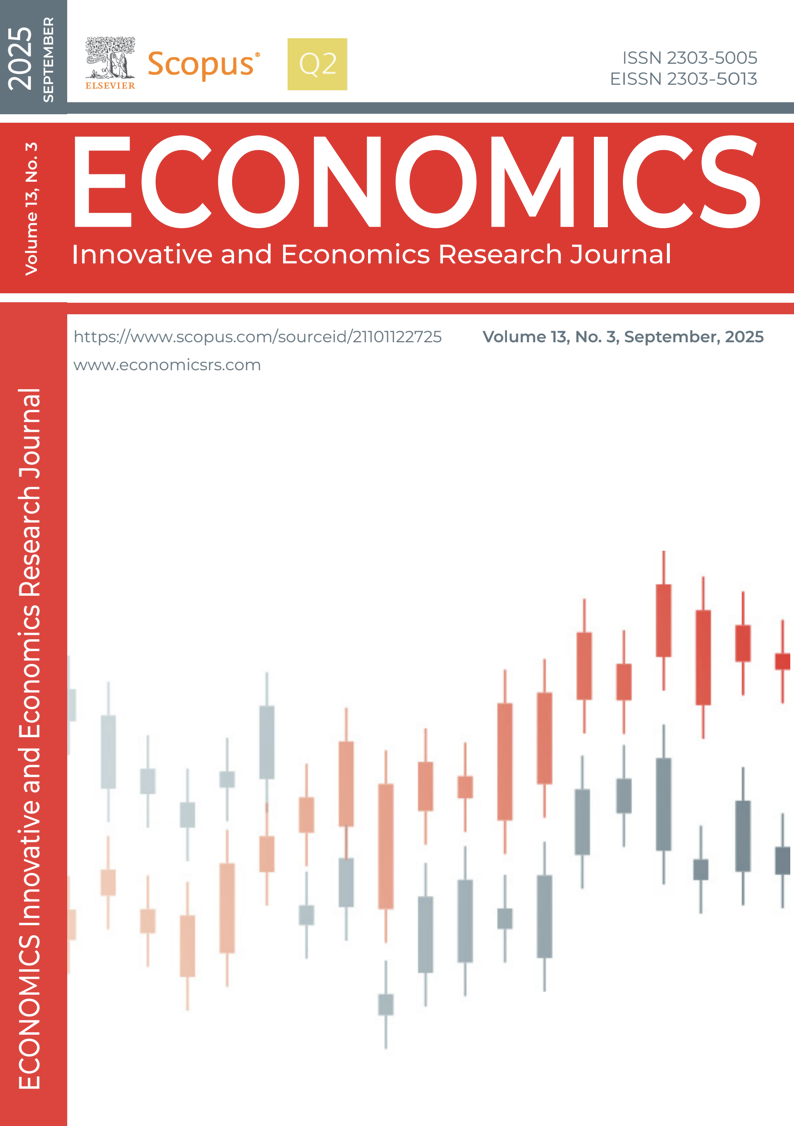ANALYZING THE ADOPTION OF GREEN TAXI SERVICES: A MULTI-STAKEHOLDER PERSPECTIVE
DOI:
https://doi.org/10.2478/eoik-2025-0069Keywords:
Green taxi, Best-Worst Method, PLS-SEM, Environmental Behavioral Intention, Multiple stakeholdersAbstract
This study explores the relationship between three dimensions (Environmental, Social, and Economic) and consumers' intention to adopt green taxis from the perspective of different stakeholders. Utilizing the Triple Bottom Line theory, the study investigates the Environmental Behavioral Intention of consumers. Consumer data was collected using a purposive sampling method, involving over 200 consumers. Additionally, 10 experts, including researchers and managers, were invited for interviews. A hybrid approach, combining Partial Least Squares Structural Equation Modelling (PLS-SEM) and multi-criteria decision-making techniques, specifically the Best-Worst Method (BWM), was employed to identify the key factors driving green taxi adoption in Vietnam. Ten hypotheses were proposed, and the results confirmed 4 out of the 10 hypotheses. The findings reveal that consumers are primarily influenced by Environmental Attitudes, Media Influence, Perceived Comfort, and Travel Time Period. In contrast, managers focus predominantly on economic factors, demonstrating a negative mindset by prioritizing economics over environmental and social dimensions, which might lead to green washing behavior. Meanwhile, researchers emphasize environmental concerns. These disparities highlight inconsistencies among stakeholders, underscoring the need for collaborative strategies that align priorities and foster the adoption of green taxi services. The government should educate the public about the negative consequences of conventional vehicles, including global warming, environmental pollution, and dependence on fossil fuels. Also, having sanctions for greenwashing firms should also be applied.
References
Abbasi, H. A., Johl, S. K., Shaari, Z. B. H., Moughal, W., Mazhar, M., Musarat, M. A., Rafiq, W., Faroo-
qi, A. S., & Borovkov, A. (2021). Consumer motivation by using unified theory of acceptance
and use of technology towards electric vehicles. Sustainability (Switzerland), 13(21). https://
doi.org/10.3390/su132112177
Adhikari, A., & Bisi, A. (2020). Collaboration, bargaining, and fairness concern for a green apparel sup-
ply chain: An emerging economy perspective. Transportation Research Part E: Logistics and
Transportation Review, 135, 101863. https://doi.org/10.1016/J.TRE.2020.101863
Ajzen, I. (1991). The theory of planned behavior. Organizational Behavior and Human Decision Pro-
cesses, 50(2), 179–211. https://doi.org/10.1016/0749-5978(91)90020-T
Alamdari, A. M., Jabarzadeh, Y., Adams, B., Samson, D., & Khanmohammadi, S. (2023). An analytic
network process model to prioritize supply chain risks in green residential megaprojects. Op-
erations Management Research, 16(1), 141–163. https://doi.org/10.1007/s12063-022-00288-2
Alan, A. K., & Kabadayı, E. T. (2014). Quality Antecedents of Brand Trust and Behavioral Intention. Proce-
dia - Social and Behavioral Sciences, 150, 619–627. https://doi.org/10.1016/j.sbspro.2014.09.081
Alemayehu Atiso, T. (2020). Battery Electric Vehicles VS Internal Combustion Engine Vehicles. Inter-
national Research Journal of Engineering and Technology. www.irjet.net
Ali, A., & Bhasin, J. (2019). Understanding Customer Repurchase Intention in E-commerce: Role of
Perceived Price, Delivery Quality, and Perceived Value. Jindal Journal of Business Research,
(2), 142–157. https://doi.org/10.1177/2278682119850275
Alizamir, S., de Véricourt, F., & Sun, P. (2016). Efficient Feed-In-Tariff Policies for Renewable Energy
Technologies. Operations Research, 64(1), 52–66. https://doi.org/10.1287/opre.2015.1460
Ananda, J., & Herath, G. (2009). A critical review of multi-criteria decision making methods with spe-
cial reference to forest management and planning. Ecological Economics, 68(10), 2535–2548.
https://doi.org/10.1016/J.ECOLECON.2009.05.010
Ansu-Mensah, P. (2021). Green product awareness effect on green purchase intentions of university
students’: an emerging market’s perspective. Future Business Journal, 7(1), 48. https://doi.
org/10.1186/s43093-021-00094-5
Armstrong, J. S., & Green, K. C. (2013). Effects of corporate social responsibility and irresponsibili-
ty policies. Journal of Business Research, 66(10), 1922–1927. https://doi.org/10.1016/j.jbus-
res.2013.02.014
Asadi, S., Nilashi, M., Samad, S., Abdullah, R., Mahmoud, M., Alkinani, M. H., & Yadegaridehkordi, E.
(2021). Factors impacting consumers’ intention toward adoption of electric vehicles in Malaysia.
Journal of Cleaner Production, 282, 124474. https://doi.org/10.1016/J.JCLEPRO.2020.124474
Balderjahn, I., Buerke, A., Kirchgeorg, M., Peyer, M., Seegebarth, B., & Wiedmann, K.-P. (2013). Conscious-
ness for sustainable consumption: scale development and new insights in the economic dimension of
consumers’ sustainability. AMS Review, 3(4), 181–192. https://doi.org/10.1007/s13162-013-0057-6
Behzadian, M., Khanmohammadi Otaghsara, S., Yazdani, M., & Ignatius, J. (2012). A state-of the-art
survey of TOPSIS applications. In Expert Systems with Applications, 39(17), 13051–13069).
Elsevier Ltd. https://doi.org/10.1016/j.eswa.2012.05.056
Cai, Y., Applegate, S., Yue, W., Cai, J., Wang, X., Liu, G., & Li, C. (2017). A hybrid life cycle and
multi-criteria decision analysis approach for identifying sustainable development strategies of
Beijing’s taxi fleet. Energy Policy, 100, 314–325. https://doi.org/10.1016/J.ENPOL.2016.09.047
Cakici, A. C., Akgunduz, Y., & Yildirim, O. (2019). The impact of perceived price justice and satis-
faction on loyalty: the mediating effect of revisit intention. Tourism Review, 74(3), 443–462.
https://doi.org/10.1108/TR-02-2018-0025
Camilleri, S. F., Montgomery, A., Visa, M. A., Schnell, J. L., Adelman, Z. E., Janssen, M., Grubert, E. A., Anen-
berg, S. C., & Horton, D. E. (2023). Air quality, health and equity implications of electrifying heavy-du-
ty vehicles. Nature Sustainability, 6(12), 1643–1653. https://doi.org/10.1038/s41893-023-01219-0
Phu N. H. et al. / Economics - Innovative and Economics Research Journal, doi: 10.2478/eoik-2025-0069
Campbell, S., Greenwood, M., Prior, S., Shearer, T., Walkem, K., Young, S., Bywaters, D., & Walker, K.
(2020). Purposive sampling: complex or simple? Research case examples. Journal of Research
in Nursing, 25(8), 652–661. https://doi.org/10.1177/1744987120927206
Caniëls, M. C. J., Lambrechts, W., Platje, J. (Joost), Motylska-Kuźma, A., & Fortuński, B. (2021). Im-
pressing my friends: The role of social value in green purchasing attitude for youthful consumers.
Journal of Cleaner Production, 303, 126993. https://doi.org/10.1016/J.JCLEPRO.2021.126993
Carrión-Bósquez, N. G., Ortiz-Regalado, O., Veas-González, I., Naranjo-Armijo, F. G., & Guerra-Re-
galado, W. F. (2024). The mediating role of attitude and environmental awareness in the influ-
ence of green advertising and eco-labels on green purchasing behaviors. Spanish Journal of
Marketing - ESIC. https://doi.org/10.1108/SJME-08-2023-0217
Cesbron, J., Bianchetti, S., Pallas, M. A., Le Bellec, A., Gary, V., & Klein, P. (2021). Road surface influ-
ence on electric vehicle noise emission at urban speed. Noise Mapping, 8(1), 217–227. https://
doi.org/10.1515/noise-2021-0017
Charnes, A., Cooper, W. W., & Rhodes, E. (1978). Measuring the efficiency of decision making units. Europe-
an Journal of Operational Research, 2(6), 429–444. https://doi.org/10.1016/0377-2217(78)90138-8
Chemama, J., Cohen, M. C., Lobel, R., & Perakis, G. (2018). Consumer Subsidies with a Strategic
Supplier: Commitment vs. Flexibility. Management Science, 65(2), 681–713. https://doi.
org/10.1287/mnsc.2017.2962
Cheung, M. L., Chau, K. Y., Lam, M. H. S., Tse, G., Ho, K. Y., Flint, S. W., Broom, D. R., Tso, E. K. H.,
& Lee, K. Y. (2019). Examining Consumers’ Adoption of Wearable Healthcare Technology: The
Role of Health Attributes. International Journal of Environmental Research and Public Health,
(13). https://doi.org/10.3390/ijerph16132257
Chi, H. K., Huang, K. C., & Nguyen, H. M. (2020). Elements of destination brand equity and destination
familiarity regarding travel intention. Journal of Retailing and Consumer Services, 52. https://
doi.org/10.1016/j.jretconser.2018.12.012
Chu, W., Im, M., Song, M. R., & Park, J. (2019). Psychological and behavioral factors affecting elec-
tric vehicle adoption and satisfaction: A comparative study of early adopters in China and
Korea. Transportation Research Part D: Transport and Environment, 76, 1–18. https://doi.
org/10.1016/j.trd.2019.09.009
Clairand, J. M., & González-Rodríguez, M. (2022). What is the level of people’s acceptance for electric
taxis and buses? Exploring citizens’ perceptions of transportation electrification to pay addition-
al fees. World Electric Vehicle Journal, 13(1). https://doi.org/10.3390/wevj13010003
Dangelico, R. M., & Pujari, D. (2010). Mainstreaming Green Product Innovation: Why and How Com-
panies Integrate Environmental Sustainability. Journal of Business Ethics, 95(3), 471–486.
https://doi.org/10.1007/s10551-010-0434-0
de Freitas Netto, S. V., Sobral, M. F. F., Ribeiro, A. R. B., & Soares, G. R. da L. (2020). Concepts and
forms of greenwashing: a systematic review. In Environmental Sciences Europe.32(1). Springer.
https://doi.org/10.1186/s12302-020-0300-3
de Vries, G. (2020). Public Communication as a Tool to Implement Environmental Policies. Social Is-
sues and Policy Review, 14(1), 244–272. https://doi.org/10.1111/sipr.12061
Dominutti, P. A., Hopkins, J. R., Shaw, M., Mills, G. P., Le, H. A., Huy, D. H., Forster, G. L., Keita,
S., Hien, T. T., & Oram, D. E. (2023). Evaluating major anthropogenic VOC emission sourc-
es in densely populated Vietnamese cities. Environmental Pollution, 318, 120927. https://doi.
org/10.1016/J.ENVPOL.2022.120927
Duarte, G., Rolim, C., & Baptista, P. (2016). How battery electric vehicles can contribute to sustainable
urban logistics: A real-world application in Lisbon, Portugal. Sustainable Energy Technologies
and Assessments, 15, 71–78. https://doi.org/10.1016/j.seta.2016.03.006
Ecer, F. (2021). A consolidated MCDM framework for performance assessment of battery electric ve-
hicles based on ranking strategies. Renewable and Sustainable Energy Reviews, 143, 110916.
https://doi.org/10.1016/J.RSER.2021.110916
Analyzing the Adoption of Green Taxi Services: A Multi-Stakeholder Perspective
Egbue, O., Long, S., & Samaranayake, V. A. (2017). Mass deployment of sustainable transportation:
evaluation of factors that influence electric vehicle adoption. Clean Technologies and Environ-
mental Policy, 19(7), 1927–1939. https://doi.org/10.1007/s10098-017-1375-4
Elkington, J. (1997). The triple bottom line. In M. D. Bazerman & D. M. Messick (Eds.), Environmental
management: Readings and cases (2nd ed., 49–66). SAGE Publications. https://books.google.
com.au/books?hl=en&lr=&id=hRJGrsGnMXcC&oi=fnd&pg=PA4
Faria, R., Marques, P., Moura, P., Freire, F., Delgado, J., & De Almeida, A. T. (2013). Impact of the
electricity mix and use profile in the life-cycle assessment of electric vehicles. Renewable and
Sustainable Energy Reviews, 24, 271–287. https://doi.org/10.1016/J.RSER.2013.03.063
Fontes, E., Moreira, A., & Carlos, V. (2021). The influence of ecological concern on green purchase be-
havior. Management & Marketing. Challenges for the Knowledge Society, 16, 246–267. https://
doi.org/10.2478/mmcks-2021-0015
Fornell, C., & Larcker, D. F. (1981). Evaluating structural equation models with unobservable variables and
measurement error. Journal of Marketing Research, 18(1), 39–50. https://doi.org/10.2307/3151312
Fu, L., Sun, Z., Zha, L., Liu, F., He, L., Sun, X., & Jing, X. (2020). Environmental awareness and pro-environ-
mental behavior within China’s road freight transportation industry: Moderating role of perceived pol-
icy effectiveness. Journal of Cleaner Production, 252. https://doi.org/10.1016/j.jclepro.2019.119796
Ghosh, A., & Satya Prasad, V. K. (2024). Evaluating the influence of environmental factors on house-
hold solar PV pro-environmental behavioral intentions: A meta-analysis review. In Renewable
and Sustainable Energy Reviews, 190. Elsevier Ltd. https://doi.org/10.1016/j.rser.2023.114047
Gleim, M., & Lawson, S. J. (2014). Spanning the gap: An examination of the factors leading to the green gap.
Journal of Consumer Marketing, 31(6–7), 503–514. https://doi.org/10.1108/JCM-05-2014-0988
Grover, P., Kar, A. K., & Dwivedi, Y. (2022). The evolution of social media influence - A literature
review and research agenda. International Journal of Information Management Data Insights,
(2), 100116. https://doi.org/10.1016/J.JJIMEI.2022.100116
Gunawan, I., Redi, A. A. N. P., Santosa, A. A., Maghfiroh, M. F. N., Pandyaswargo, A. H., & Kurniawan,
A. C. (2022). Determinants of Customer Intentions to Use Electric Vehicle in Indonesia: An Inte-
grated Model Analysis. Sustainability (Switzerland), 14(4). https://doi.org/10.3390/su14041972
Guo, C., Lv, S., Liu, Y., & Li, Y. (2022). Biomarkers for the adverse effects on respiratory system health
associated with atmospheric particulate matter exposure. In Journal of Hazardous Materials,
Elsevier B.V. https://doi.org/10.1016/j.jhazmat.2021.126760
Habibi, A., & Rasoolimanesh, S. M. (2021). Experience and Service Quality on Perceived Value and Be-
havioral Intention: Moderating Effect of Perceived Risk and Fee. Journal of Quality Assurance
in Hospitality and Tourism, 22(6), 711–737. https://doi.org/10.1080/1528008X.2020.1837050
Haghani, M., Sprei, F., Kazemzadeh, K., Shahhoseini, Z., & Aghaei, J. (2023). Trends in electric ve-
hicles research. Transportation Research Part D: Transport and Environment, 123, 103881.
https://doi.org/10.1016/J.TRD.2023.103881
Hair, J. F., Black, W. C., Babin, B. J., & Anderson, R. E. (2010). Multivariate data analysis: A global
perspective (7th ed.). Pearson Education. https://books.google.com.au/books/about/Multivari-
ate_Data_Analysis.html?id=SLRPLgAACAAJ&redir_esc=y
Hair, J. F., Jr., Hult, G. T. M., Ringle, C. M., & Sarstedt, M. (2017). A primer on partial least squares structur-
al equation modeling (PLS-SEM) (2nd ed.). SAGE Publications. https://lccn.loc.gov/2016005380
Hamurcu, M., & Eren, T. (2020). Electric Bus Selection with Multicriteria Decision Analysis for Green
Transportation. Sustainability, 12(7). https://doi.org/10.3390/su12072777
He, L., & Chen, L. (2021). The incentive effects of different government subsidy policies on green
buildings. Renewable and Sustainable Energy Reviews, 135, 110123. https://doi.org/10.1016/J.
RSER.2020.110123
He, X., Zhan, W., & Hu, Y. (2018). Consumer purchase intention of electric vehicles in China: The
roles of perception and personality. Journal of Cleaner Production, 204, 1060–1069. https://doi.
org/10.1016/j.jclepro.2018.08.260
Phu N. H. et al. / Economics - Innovative and Economics Research Journal, doi: 10.2478/eoik-2025-0069
Henseler, J., Ringle, C. M., & Sinkovics, R. R. (2009). The use of partial least squares path model-
ing in international marketing. Advances in International Marketing, 20, 277–319. https://doi.
org/10.1108/S1474-7979(2009)0000020014
Hoang Yen, N. T., & Hoang, D. P. (2023). The formation of attitudes and intention towards green pur-
chase: An analysis of internal and external mechanisms. Cogent Business and Management,
(1). https://doi.org/10.1080/23311975.2023.2192844
Hosseinzadeh Lotfi, F., Allahviranloo, T., Pedrycz, W., Shahriari, M., Sharafi, H., & Razipour Ghaleh-
Jough, S. (2023). The Measuring Attractiveness by a Categorical Based Evaluation Technique
(MACBETH) in Uncertainty Environment. In F. Hosseinzadeh Lotfi, T. Allahviranloo, W. Pe-
drycz, M. Shahriari, H. Sharafi, & S. Razipour GhalehJough (Eds.), Fuzzy Decision Analysis:
Multi Attribute Decision Making Approach, 257–273. Springer International Publishing. https://
doi.org/10.1007/978-3-031-44742-6_10
Huu, D. N., & Ngoc, V. N. (2021). Analysis study of current transportation status in vietnam’s urban
traffic and the transition to electric two-wheelers mobility. Sustainability (Switzerland), 13(10).
https://doi.org/10.3390/su13105577
IQAir. (2023). World Air Quality Report. https://www.iqair.com/dl/2023_World_Air_Quality_Report.pdf
Idris, A., & Razak, A. R. (2025). Energy transition, green growth and emission on economic growth
using spline approach: Evidence from Asia-pasific countries. Economics - innovative and eco-
nomics research journal, 13(2), 139–159. https://doi.org/10.2478/eoik-2025-0034
Irfan, M., & Ahmad, M. (2021). Relating consumers’ information and willingness to buy electric vehi-
cles: Does personality matter? Transportation Research Part D: Transport and Environment,
, 103049. https://doi.org/10.1016/J.TRD.2021.103049
Jain, N. K., Bhaskar, K., & Jain, S. (2022). What drives adoption intention of electric vehicles in India? An
integrated UTAUT model with environmental concerns, perceived risk and government support. Re-
search in Transportation Business and Management, 42. https://doi.org/10.1016/j.rtbm.2021.100730
Jaiswal, D., Kaushal, V., Kant, R., & Kumar Singh, P. (2021). Consumer adoption intention for electric
vehicles: Insights and evidence from Indian sustainable transportation. Technological Forecast-
ing and Social Change, 173, 121089. https://doi.org/10.1016/J.TECHFORE.2021.121089
Jayasingh, S., Girija, T., & Arunkumar, S. (2021). Factors Influencing Consumers’ Purchase Intention
towards Electric Two-Wheelers. Sustainability, 13(22). https://doi.org/10.3390/su132212851
Keshavarz-Ghorabaee, M., Amiri, M., Hashemi-Tabatabaei, M., & Ghahremanloo, M. (2021).
Sustainable Public Transportation Evaluation using a Novel Hybrid Method Based on
Fuzzy BWM and MABAC. The Open Transportation Journal, 15(1), 31–46. https://doi.
org/10.2174/1874447802115010031
Khalid, A. M. Bin, Ud Din, S., Khan, M. A., & Ehsan, S. (2024). Investigating behavioral intentions
towards paratransit services for enhancing accessibility at metro bus stations. Ain Shams Engi-
neering Journal, 103141. https://doi.org/10.1016/J.ASEJ.2024.103141
Khan, S. N., & Mohsin, M. (2017). The power of emotional value: Exploring the effects of values on
green product consumer choice behavior. Journal of Cleaner Production, 150, 65–74. https://
doi.org/10.1016/j.jclepro.2017.02.187
Kock, N. (2015). Common method bias in PLS-SEM: A full collinearity assessment approach. Interna-
tional Journal of E-Collaboration, 11(4), 1–10. https://doi.org/10.4018/ijec.2015100101
Kollmuss, A., & Agyeman, J. (2002). Mind the Gap: Why do people act environmentally and what are
the barriers to pro-environmental behavior? Environmental Education Research, 8(3), 239–260.
https://doi.org/10.1080/13504620220145401
Krass, D., Nedorezov, T., & Ovchinnikov, A. (2013). Environmental Taxes and the Choice of Green Technolo-
gy. Production and Operations Management, 22(5), 1035–1055. https://doi.org/10.1111/poms.12023
Krishnasarma, A., Yazdi, S. J. M., Taylor, A., Ludwigsen, D., & Baqersad, J. (2021). Acoustic signature
analysis and sound source localization for a three-phase ac induction motor. Energies, 14(21).
https://doi.org/10.3390/en14217182
Analyzing the Adoption of Green Taxi Services: A Multi-Stakeholder Perspective
Kuzmak, O., & Kuzmak, O. (2023). Social Responsibility of Business towards Sustainable Develop-
ment: Case of Ukraine. Collection of papers new economy volume, 1(1), 126-148. https://doi.
org/10.61432/CPNE0101126k
Kwok, C. P., & Tang, Y. M. (2023). A fuzzy MCDM approach to support customer-centric innovation in
virtual reality (VR) metaverse headset design. Advanced Engineering Informatics, 56, 101910.
https://doi.org/10.1016/j.aei.2023.101910
Lago, N. C., Marcon, A., Ribeiro, J. L. D., de Medeiros, J. F., Brião, V. B., & Antoni, V. L. (2020).
Determinant attributes and the compensatory judgement rules applied by young consumers to
purchase environmentally sustainable food products. Sustainable Production and Consumption,
, 256–273. https://doi.org/10.1016/J.SPC.2020.06.003
Lambrechts, W., Ghijsen, P. W. T., Jacques, A., Walravens, H., Van Liedekerke, L., & Van Petegem, P.
(2018). Sustainability segmentation of business students: Toward self-regulated development
of critical and interpretational competences in a post-truth era. Journal of Cleaner Production,
, 561–570. https://doi.org/10.1016/J.JCLEPRO.2018.07.303
Langbroek, J. H. M., Franklin, J. P., & Susilo, Y. O. (2016). The effect of policy incentives on electric
vehicle adoption. Energy Policy, 94, 94–103. https://doi.org/10.1016/j.enpol.2016.03.050
Lemaallem, H., & Saadi, A. (2025). Productivity and Trade Openness: A Sectoral Analysis of Morocco’s
Economy. Economics - innovative and economics research journal, 13(2), 529–551. https://doi.
org/10.2478/eoik-2025-0052
Li, X., Yu, R., & Su, X. (2021). Environmental Beliefs and Pro-Environmental Behavioral Intention of
an Environmentally Themed Exhibition Audience: The Mediation Role of Exhibition Attach-
ment. SAGE Open, 11(2). https://doi.org/10.1177/21582440211027966
Li, Z., Khajepour, A., & Song, J. (2019). A comprehensive review of the key technologies for pure elec-
tric vehicles. Energy, 182, 824–839. https://doi.org/10.1016/J.ENERGY.2019.06.077
López-Mosquera, N., Lera-López, F., & Sánchez, M. (2015). Key factors to explain recycling, car use
and environmentally responsible purchase behaviors: A comparative perspective. Resources,
Conservation and Recycling, 99, 29–39. https://doi.org/10.1016/j.resconrec.2015.03.007
Lowry, P. B., & Gaskin, J. (2014). Partial least squares (PLS) structural equation modeling (SEM) for build-
ing and testing behavioral causal theory: When to choose it and how to use it. IEEE Transactions
on Professional Communication, 57(2), 123–146. https://doi.org/10.1109/TPC.2014.2312452
Mahdiraji, H. A., Arzaghi, S., Stauskis, G., & Zavadskas, E. K. (2018). A hybrid fuzzy BWM-COPRAS
method for analyzing key factors of sustainable architecture. Sustainability (Switzerland), 10(5).
https://doi.org/10.3390/su10051626
Mastilo, Z., Barić, F. & Puška, A. (2025). Challenges and Opportunities of Implementing Digital Pay-
ment Systems in Southeast European Countries. Journal of Central Banking Theory and Prac-
tice, 14(2), 5-28. https://doi.org/10.2478/jcbtp-2025-0011
Mathwick, C., Malhotra, N., & Rigdon, E. (2001). Experiential value: conceptualization, measurement
and application in the catalog and Internet shopping environment☆. Journal of Retailing, 77(1),
–56. https://doi.org/10.1016/S0022-4359(00)00045-2
Mohd Suki, N., & Mohd Suki, N. (2019). Examination of peer influence as a moderator and predictor in
explaining green purchase behaviour in a developing country. Journal of Cleaner Production,
, 833–844. https://doi.org/10.1016/J.JCLEPRO.2019.04.218
Moktadir, Md. A., & Ren, J. (2024). Towards green logistics: An innovative decision support model for
zero-emission transportation modes development. Transportation Research Part E: Logistics
and Transportation Review, 189, 103648. https://doi.org/10.1016/j.tre.2024.103648
Munim, Z. H., & Noor, T. (2020). Young people’s perceived service quality and environmental perfor-
mance of hybrid electric bus service. Travel Behaviour and Society, 20, 133–143. https://doi.
org/10.1016/j.tbs.2020.03.003
Phu N. H. et al. / Economics - Innovative and Economics Research Journal, doi: 10.2478/eoik-2025-0069
Nghia, L. V., Hue, L., Dam Hoang Phuc, Duong Ngoc Khanh, & Dat, B. T. (2024). The Efficiency of
Changing Traditional Vehicle by EVs on Taxi Service: A Case Study on the Energy Consump-
tion and Emission Levels in Hanoi City. Lecture Notes in Networks and Systems, 480–488.
https://doi.org/10.1007/978-3-031-62235-9_48
Nguyen Ngoc Minh. (2024). Social media in Vietnam - statistics & facts. https://www.statista.com/top-
ics/8182/social-media-in-vietnam/#topicOverview
Nguyễn Thúc Hoàng Linh. (2024, May 24). Xe điện làm taxi: Nhiều tiềm năng, lắm thách thức! https://
hanoimoi.vn/xe-dien-lam-taxi-nhieu-tiem-nang-lam-thach-thuc-667331.html#:~:text=Theo%20
th%E1%BB%91ng%20k%C3%AA%20c%E1%BB%A7a%20B%C3%A1o,%C4%91i%E1%B-
B%87n%20ho%C3%A1%20100%25%20ph%C6%B0%C6%A1ng%20ti%E1%BB%87n.
Okada, T., Tamaki, T., & Managi, S. (2019). Effect of environmental awareness on purchase intention
and satisfaction pertaining to electric vehicles in Japan. Transportation Research Part D: Trans-
port and Environment, 67, 503–513. https://doi.org/10.1016/J.TRD.2019.01.012
Osswald, S., Wurhofer, D., Trösterer, S., Beck, E., & Tscheligi, M. (2012). Predicting informa-
tion technology usage in the car: towards a car technology acceptance model. https://doi.
org/10.1145/2390256.2390264
Ozaki, R. (2011). Adopting sustainable innovation: what makes consumers sign up to green electricity?
Business Strategy and the Environment, 20(1), 1–17. https://doi.org/https://doi.org/10.1002/bse.650
Pagiaslis, A., & Krontalis, A. K. (2014). Green Consumption Behavior Antecedents: Environmental
Concern, Knowledge, and Beliefs. Psychology & Marketing, 31(5), 335–348. https://doi.org/
https://doi.org/10.1002/mar.20698
Qian, L., & Yin, J. (2017). Linking Chinese cultural values and the adoption of electric vehicles: The
mediating role of ethical evaluation. Transportation Research Part D: Transport and Environ-
ment, 56, 175–188. https://doi.org/10.1016/j.trd.2017.07.029
Rezaei, J. (2015). Best-worst multi-criteria decision-making method. Omega (United Kingdom), 53,
–57. https://doi.org/10.1016/j.omega.2014.11.009
Rustam, A., Wang, Y., & Zameer, H. (2020). Environmental awareness, firm sustainability exposure
and green consumption behaviors. Journal of Cleaner Production, 268, 122016. https://doi.
org/10.1016/j.jclepro.2020.122016
Saaty, R. W. (1987). The analytic hierarchy process—what it is and how it is used. Mathematical Mod-
elling, 9(3–5), 161–176. https://doi.org/10.1016/0270-0255(87)90473-8
Safarzadeh, S., Khansefid, S., & Rasti-Barzoki, M. (2018). A group multi-criteria decision-making
based on best-worst method. Computers and Industrial Engineering, 126, 111–121. https://doi.
org/10.1016/j.cie.2018.09.011
Sisani, F., Di Maria, F., & Cesari, D. (2022). Environmental and human health impact of different
powertrain passenger cars in a life cycle perspective. A focus on health risk and oxidative po-
tential of particulate matter components. Science of the Total Environment, 805. https://doi.
org/10.1016/j.scitotenv.2021.150171
Song, J. (2014). Understanding the adoption of mobile innovation in China. Computers in Human Be-
havior, 38, 339–348. https://doi.org/10.1016/j.chb.2014.06.016
Stević, Ž., Pamučar, D., Zavadskas, E. K., Ćirović, G., & Prentkovskis, O. (2017). The selection of wag-
ons for the internal transport of a logistics company: A novel approach based on rough BWM
and rough SAW methods. Symmetry, 9(11). https://doi.org/10.3390/sym9110264
Stockbiz. (2024, March 1). Hơn 72 triệu xe máy xăng ra đường, ô nhiễm nặng nề, chuyển nhanh sang
xe máy điện. https://stockbiz.vn/tin-tuc/hon-72-trieu-xe-may-xang-ra-duong-o-nhiem-nang-ne-
chuyen-nhanh-sang-xe-may-dien/23566513
Sun, Y., Liu, N., & Zhao, M. (2019). Factors and mechanisms affecting green consumption in China:
A multilevel analysis. Journal of Cleaner Production, 209, 481–493. https://doi.org/10.1016/J.
JCLEPRO.2018.10.241
Analyzing the Adoption of Green Taxi Services: A Multi-Stakeholder Perspective
Survey Response - an overview | ScienceDirect Topics. (n.d.). Retrieved November 14, 2024. https://
www.sciencedirect.com/topics/computer-science/survey-response
Takala, M. (1991). Environmental Awareness and Human Activity. International Journal of Psychology,
(5), 585–597. https://doi.org/10.1080/00207599108247146
Tan, W. K., & Wu, C. E. (2016). An investigation of the relationships among destination familiarity, des-
tination image and future visit intention. Journal of Destination Marketing and Management,
(3), 214–226. https://doi.org/10.1016/j.jdmm.2015.12.008
Tanwir, N. S., & Hamzah, M. I. (2020). Predicting purchase intention of hybrid electric vehicles: Evi-
dence from an emerging economy. World Electric Vehicle Journal, 11(2). https://doi.org/10.3390/
WEVJ11020035
Thi Mai, A. N., Xuan, V. N., Mai, H. Le, Xuan, H. P., & Thi Phuong, T. N. (2024). Population, carbon
dioxide emissions and renewable energy consumption nexus: New insights from Vietnam. Ener-
gy Exploration & Exploitation, 42(5), 1763–1798. https://doi.org/10.1177/01445987241252453
Trivedi, R. H., Patel, J. D., & Acharya, N. (2018). Causality analysis of media influence on environmen-
tal attitude, intention and behaviors leading to green purchasing. Journal of Cleaner Production,
, 11–22. https://doi.org/10.1016/J.JCLEPRO.2018.06.024
United Nations. (2021). Recommendations for green and healthy sustainable transport: Building for-
ward better. https://unece.org/sites/default/files/2023-06/2101940_E_PDF_WEB.pdf
van Griethuijsen, R. A. L. F., van Eijck, M. W., Haste, H., den Brok, P. J., Skinner, N. C., Mansour, N., Genc-
er, A. S., & BouJaoude, S. (2015). Global patterns in students’ views of science and interest in sci-
ence. Research in Science Education, 45(4), 581–603. https://doi.org/10.1007/s11165-014-9438-6
Varela-Candamio, L., Novo-Corti, I., & García-Álvarez, M. T. (2018). The importance of environmental
education in the determinants of green behavior: A meta-analysis approach. Journal of Cleaner
Production, 170, 1565–1578. https://doi.org/10.1016/J.JCLEPRO.2017.09.214
Venkatesh, V., Morris, M. G., Davis, G. B., & Davis, F. D. (2003, September). User Acceptance of
Information Technology: Toward a Unified View. ResearchGate; University of Minnesota,
Management Information Systems Research Center. https://www.researchgate.net/publica-
tion/220259897_User_Acceptance_of_Information_Technology_Toward_a_Unified_View
Wadud, Z., & Huda, F. Y. (2019). Fully automated vehicles: the use of travel time and its association
with intention to use. Proceedings of the Institution of Civil Engineers: Transport, 176(3), 127–
https://doi.org/10.1680/jtran.18.00134
Wang, C.-N., & Nguyen, H.-P. (2022). Evaluating the sustainability of hotels using multi-criteria deci-
sion making methods. Proceedings of the Institution of Civil Engineers - Engineering Sustain-
ability, 175(3), 129–140. https://doi.org/10.1680/jensu.21.00084
Wang, F. J., Hsiao, C. H., Shih, W. H., & Chiu, W. (2023). Impacts of Price and Quality Perceptions on
Individuals’ Intention to Participate in Marathon Events: Mediating Role of Perceived Value.
SAGE Open, 13(2). https://doi.org/10.1177/21582440231181431
Wang, N., Xu, Y., Puška, A., Stević, Ž., & Alrasheedi, A. F. (2023). Multi-Criteria Selection of Electric
Delivery Vehicles Using Fuzzy–Rough Methods. Sustainability (Switzerland), 15(21). https://
doi.org/10.3390/su152115541
Wang, P., Liu, Q., & Qi, Y. (2014). Factors influencing sustainable consumption behaviors: A sur-
vey of the rural residents in China. Journal of Cleaner Production, 63, 152–165. https://doi.
org/10.1016/j.jclepro.2013.05.007
Wang, X., Yu, C., & Wei, Y. (2012). Social Media Peer Communication and Impacts on Purchase Inten-
tions: A Consumer Socialization Framework. Journal of Interactive Marketing, 26(4), 198–208.
https://doi.org/10.1016/j.intmar.2011.11.004
Weigel, R., & Weigel, J. (1978). Environmental concern: The Development of a Measure. Environment
and Behavior, 10(1), 3–15. https://doi.org/10.1177/0013916578101001
Phu N. H. et al. / Economics - Innovative and Economics Research Journal, doi: 10.2478/eoik-2025-0069
Weissmann, M. A., & Hock, R. L. T. (2022). Making Sustainable Consumption Decisions: The Effects
of Product Availability on Product Purchase Intention. Journal of Global Marketing, 35(4),
–284. https://doi.org/10.1080/08911762.2021.1983686
WHO. (2024). Two National Consultants to provide consultancy services in piloting tools for carbon emission
assessment in healthcare facilities and health system. https://vietnam.un.org/en/269290-015-two-na-
tional-consultants-provide-consultancy-services-piloting-tools-carbon-emission
Wijekoon, R., & Sabri, M. F. (2021). Determinants that influence green product purchase intention and
behavior: A literature review and guiding framework. In Sustainability (Switzerland), 13(11).
MDPI AG. https://doi.org/10.3390/su13116219
Wolske, K. S., Gillingham, K. T., & Schultz, P. W. (2020). Peer influence on household energy be-
haviours. Nature Energy, 5(3), 202–212. https://doi.org/10.1038/s41560-019-0541-9
Woody, M., Adderly, S. A., Bohra, R., & Keoleian, G. A. (2024). Electric and gasoline vehicle total
cost of ownership across US cities. Journal of Industrial Ecology, 28(2), 194–215. https://doi.
org/10.1111/jiec.13463
Wu, J., Ahmad, S. F., Jaweria, Ali, Y. A., Al-Razgan, M., Awwad, E. M., & Bani Ahmad Ayassrah, A. Y.
A. (2024). Investigating the role of green behavior and perceived benefits in shaping green car
buying behavior with environmental awareness as a moderator. Heliyon, 10(9), e30098. https://
doi.org/10.1016/j.heliyon.2024.e30098
Xu, X., Wang, S., & Yu, Y. (2020). Consumer’s intention to purchase green furniture: Do health con-
sciousness and environmental awareness matter? Science of The Total Environment, 704,
https://doi.org/10.1016/J.SCITOTENV.2019.135275
Yang, M., Chen, H., Long, R., & Yang, J. (2023). How does government regulation shape residents’ green
consumption behavior? A multi-agent simulation considering environmental values and social
interaction. Journal of Environmental Management, 331, 117231. https://doi.org/10.1016/J.
JENVMAN.2023.117231
Yang, W., & Le, B. A. P. (2023). Do consumers care about environmentally sustainable attributes along
the food supply chain? —A systematic literature review. In AIMS Agriculture and Food , 8(2),
–533. AIMS Press. https://doi.org/10.3934/AGRFOOD.2023027
Yavuz, A., Hazar-Yavuz, A. N., & Hacibektaşoğlu, S. E. (2024). Vehicle noise pollution awareness for human
health and environmental impacts: A comprehensive review. In Acta Pharmaceutica Sciencia, 62(2),
–266. Istanbul Medipol University. https://www.actapharmsci.com/uploads/pdf/pdf_869.pdf
Yuniza, M. E., Pratama, I. W. B. E., & Ramadhaniati, R. C. (2021). Indonesia’s incentive policies on
electric vehicles: The questionable effort from the government. International Journal of Energy
Economics and Policy, 11(5), 434–440. https://doi.org/10.32479/ijeep.11453
Yuriev, A., Boiral, O., Francoeur, V., & Paillé, P. (2018). Overcoming the barriers to pro-environmental
behaviors in the workplace: A systematic review. Journal of Cleaner Production, 182, 379–394.
https://doi.org/10.1016/J.JCLEPRO.2018.02.041
Zhang, Y., Yu, Y., & Zou, B. (2011). Analyzing public awareness and acceptance of alternative fuel ve-
hicles in China: The case of EV. Energy Policy, 39(11), 7015–7024. https://doi.org/10.1016/J.
ENPOL.2011.07.055
Downloads
Published
How to Cite
Issue
Section
License
Copyright (c) 2025 ECONOMICS - INNOVATIVE AND ECONOMICS RESEARCH JOURNAL

This work is licensed under a Creative Commons Attribution-NonCommercial-NoDerivatives 4.0 International License.























